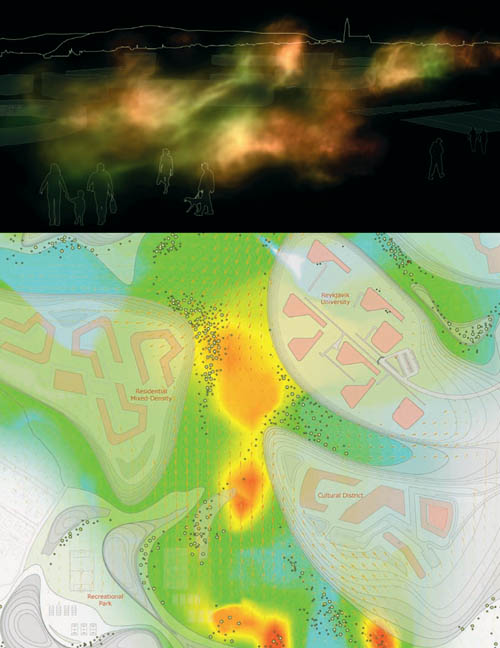By now, you've no doubt heard of the so-called "death ray" in Las Vegas, caused by the curved surface of the newly constructed Vdara Hotel. The hotel's facade acts as a parabolic reflector, concentrating solar heat into a specific target area—enough to melt plastic drinking cups and even burn people's hair. It's the future of urban thermal warfare, perhaps: hotels armed against other hotels in a robust defense posture defined by pure heat.
Of course, Frank Gehry's Disney Concert Hall here in Los Angeles had its own "microclimatic impact," as this PDF makes clear. Back in 2004, USA Today explained that "the glare off the shimmering stainless steel curves at the Frank Gehry-designed Walt Disney Concert Hall is so bad, it's heating up nearby condos at least 15 degrees and forcing owners to crank up their air conditioners." [Image: By Sean Lally, Andrew Corrigan, and Paul Kweton of WEATHERS].
[Image: By Sean Lally, Andrew Corrigan, and Paul Kweton of WEATHERS].
Oddly, though, this same heat-reflection effect came up recently in a course I'm currently teaching; a student and I were looking at a project by Sean Lally, Andrew Corrigan, and Paul Kweton of WEATHERS (previously documented on BLDGBLOG here).
That project proposed not really building anything at all but simply tapping the geothermal energy available beneath the Icelandic capital of Reykjavik to create "microclimates" around the city. "Heat is taken directly from the ground," they explain, "and piped up across the landscape into a system of [pipes and] towers."
However, the question here would be: could you deliberately design an architecture without walls, using only thermal gradients—defining areas of public use and congregation solely based on heat? Could these and other parabolic reflections of solar energy be deliberately used as a tactic of architectural intervention and urban design? CTC™: Controlled Thermal Concentration.
Minneapolis-St. Paul, for instance, gets a series of strange pavilion-like stands topped with polished reflectors—and they're ugly as hell, and they make no sense at all except as bad public art, until you stand right next to them. All the snow around them has melted, you first notice, and you can actually stand there without a jacket on even in the depths of winter.
They are "buildings" without definable perimeter, shimmering with daily changes in heat—not a blur building, we might say, but a mirage. Which, I suppose, brings us back to Las Vegas...
Lưu trữ Blog
-
▼
2010
(3068)
-
▼
tháng 9
(255)
- Filosoferande på hög nivå
- The Social Network
- My favourite things...
- The Austrians never cease to amaze me
- Climbing and Outdoor News from Here and Abroad - 9...
- radio
- Holiday Reflections - Good Golly Miss Holly Style
- Holiday Reflections - The Mummy Diaries Style.
- Mantid Reproduction Story
- The Great Experiment
- And the winner is.....!
- Cheez-on-Indian
- Homemade Apricot and Dark Chocolate Granola Bars
- Bus
- Through the City with a Sharpie
- Las Vegas Death Ray
- Vs.
- WTF is it about Cupcakes?
- Android poster design
- Conditions Report - September 29 2010
- DELAY TREES - S.T.
- Vardagslyx
- Dear Mr Woog
- Ermita
- Lite nytt
- They are ugly AND they don’t work
- Mount Baker Skills and Climb
- Om morgonlufsande
- It's just food
- "One-eyed" mantid update
- Porch katydid
- Little screen door spider
- Early Morning Spider
- Hotter than a spider in a metal pipe
- It started with a lemonade icy-pole....
- Does it matter when you are dead?
- DEERHUNTER - HALCYON DIGEST
- Butterfly moments
- Comanche Wilderness Loop
- I don't know why she does it
- Älskade, finaste skatås/hösten/löpningen
- Chocolate Raspberry Cake
- Week Ending September 26
- October and November Climbing Events
- Sanndröm?
- This weekend I'm grateful for...
- Sunday
- Playlist - 25th September 2010
- 8.10.
- Weekend Warrior - Videos to get you stoked!
- En liten tår i ögonvrån
- 11
- Saturday's Special Edition
- Saturdays without SawHole
- Counter-What?: An Interview with Jeffrey Inaba
- Thank You
- postcards
- Sukkah
- The Malmbergs: Putting the Hurt on the Hill
- North Cascades Backpacking Trip
- EL GUINCHO - "BOMBAY" MUSIC VIDEO
- I suspect a McChicken might be in order....
- Apologies
- Fabrice Fabrice Caprese
- Midtown Manhattan, New York City, from Rockefeller...
- Climbing and Outdoor News from Here and Abroad - 9...
- We Blew It
- WTF is this cardboard doing in here?
- Is it a boy or a girl?
- Not taking her call.
- Edgar Martinez throws baseball, earth impacted bey...
- Memories of the Mundane
- Homemade Dark Chocolate Salty Peanut Butter Cups
- On clouds
- Special effects of a timestretched present
- Don’t ask, don’t tell - just Bugger Off!
- Netflix Launches in Canada
- Conditions Report - September 22 2010
- Mush!
- Your Thoughts Please......
- Car Park Picturesque
- The New Yorker
- Steve Jobs bust
- A Traffic Jam is a Collection of Rooms
- Denali Park Road Open to Mile 30 through September
- Haute Route Trekking
- SLEIGH BELLS - INFINITY GUITARS
- No - he was a Catholic - like you!
- Of networked buildings and architectural neurology
- Ingen ordning
- Cupcakes, Frocks and Pink with a side of Woog
- Chateau de Woog
- PHOTOGRAPHY OF DEREK VINCENT
- LOVED ON WATER
- The East Villager
- 1970 Dodge Pickup Truck
- Angle and Force in an Anchor
- A gourmet giveaway
- Signal Mountain/Lookout Mountain Looper
- Fortnight Ending September 19
-
▼
tháng 9
(255)